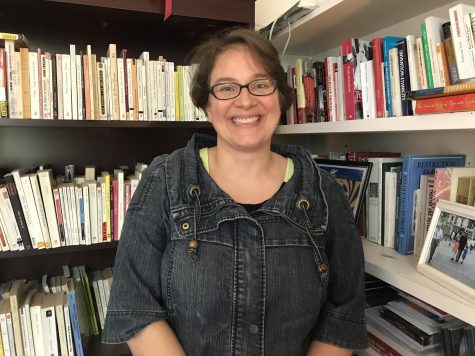Reeck publishes chapter in Oxford Handbook
Professor of Modern and Classical Languages and Chair of International Studies Laura Reeck contributed a chapter to the Oxford Handbook of Arab Novelistic Traditions, released in print on Sept. 1.
Reeck said she submitted her chapter in August 2014 after Waïl Hassan, the handbook project director, contacted her in May 2014. The Handbook consists of 42 chapters, is organized into three sections and serves as a reference tool, Reeck said.
“The first section is looking at basically the origins of the novel in Arabic, so it’s focusing especially on the 19th century and the way in which the Arabic novel developed in that historical context,” Reeck said. “The second part of the handbook looks at how the Arabic language novel then basically got installed in different Arabic speaking countries. The third part of the handbook is about diasporas, and that was the section he was asking me to write for.”

Laura Reeck, professor of modern and classical
languages and international studies chair.
Tradition after the Six-Day War
In the Middle East more broadly, novelistic traditions experienced a major shift in the 20th century, according to Assistant Professor of Modern and Classical Languages Reem Hilal who teaches the course “The Arab Novel in Translation.”
Hilal said Middle Eastern writers in the 1950s focused on the hope of independence from Great Britain and France in their novels until the Israeli victory in the Six-Day War between Israel and the surrounding Arab countries in 1967.
“1967 was incredibly devastating in terms of the Arab psyche — that they had been defeated so quickly, especially because the Egyptian president at that time, Gamal Abdel Nasser, had really sort of hyped the successes of the Egyptian army and that this was going to be an easy victory,” Hilal said. “When they lost so quickly and so badly it really forced the Arab nations to reevaluate this new hope that they had after independence.”
Hilal said novelists began to reflect on social conditions, including the role of women, minority groups and war.
“A lot of these novels — because of the political reality of the Middle East — really look at the question of war, looking at its impact, not only on the political discourse, but what kinds of effects it has on the nation’s body in that kind of abstract way,” Hilal said. “But also what kind of impact it has on individual bodies, how people learn to cope with war and different kinds of war.”
According to Hilal, Arab novelistic traditions are deeply rooted in and complicated by language, especially in terms of colonial history in the Middle East.
“If you’re not able to write in Arabic, that already poses a problem in terms of your own understanding of your identity,” Hilal said. “I remember when I was in graduate school, we read an Algerian writer who wrote in French, and part of her novel was really thinking about that question of ‘I’m forced to write in the colonizer’s language because I’ve been disconnected, not only from Arabic but Berber’ because that’s the language that she speaks, that her family speaks at home. That question of language becomes more than just ‘I need a language to write down.’ It’s a language that’s loaded with a history.”
Tradition in Diasporic France
Reeck said she had an ongoing discussion with Hassan about the phrase, “Arab diasporic novel,” before agreeing to write the chapter.
“One of the biggest complications in the case of France is that one of the largest groups to immigrate to France has been from North Africa,” Reeck said. “Among North Africans there have been both Arabs and Berbers — Berbers are the indigenous people who lived in Northern Africa before the Arabs arrived.”
Reeck said areas in northern Africa are still home to distinct Berber communities.
“So to say the ‘Arab diasporic novel’ in some ways elides an ethnic identity,” Reeck said.
Reeck’s chapter appears in the third part of the handbook and discusses three groups of writers within diasporic France: Independence-era Algerian and Moroccan writers, writers in exile during the Lebanese Civil War and second-generation North African writers.
“The novels I talk about in most cases, apart from some historical novels, are set in France, or interested in France,” Reeck said. “These different sets of writers are all interested, in their own way, in biculturalism, multilingualism, displacement whether that would be exile or immigration and ultimately very interested in incorporation.”
Second-generation Writers in France
Generally, writers of the first two groups have provided more distinct historical perspectives from the 1950s to 1990s, written more conventionally and experienced great intellectual opportunities, according to Reeck.
Reeck said two writers within those first two groups have even been elected to the Académie Française, a renowned French literary institution — Assia Djebar in 2005 and Amin Maalouf in 2011.
But writers of the third group Reeck discusses in the chapter have struggled to reach the same levels of acclaim.
“The second-generation North African writers really only came to be known in the 1980s,” Reeck said. “It was the very first ethnic minority literature that was basically born in and to France. They’re in a very different position, they’re valued very differently in France, and I think that’s important.”
Reeck said works by the second-generation writers don’t reflect the same social experiences of their predecessors and don’t typically align with the literary conventions of France.
Allegheny’s “Writing and Society” course in the French program discusses second generation French citizens, especially in terms of social experiences and banlieues — suburbs.
“In France I think it’s interesting how there are identity crises in the banlieues because a lot of the people who live in the banlieues are of North African descent and they have trouble fitting into the French society,” said Lucas Proper, ’18, who took the “Writing and Society” course in 2016. “[Banlieue] is also referred to as no man’s land, they’re just stuck in the middle — they can’t identify with where they come from, and they can’t identify with where they are now.”
Reeck said when these second-generation writers write about France, they aren’t writing about France as home, but many of these writers have also never been to the countries from which their parents came.
“Their writing is very marked by their many cultural influences — by slang, by youth culture, a global kind of music and so it doesn’t read in the same way a lot of the fiction by the writers in the other two groups does,” Reeck said.
When Reeck worked on the chapter, she looked at contemporary second-generation writers, and Reeck said she has some concerns about the exclusion of some writers that have emerged since she wrote the chapter in 2014.
“In some ways it’s always going to be a little imperfect,” Reeck said. “I just hope that I got it right to the extent that the chapter is meaningful and makes sense.”







